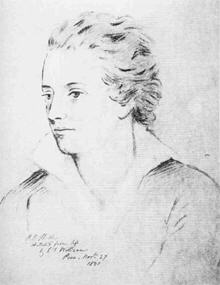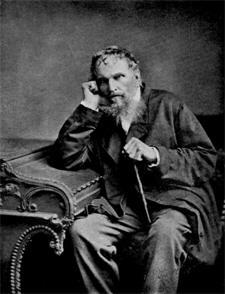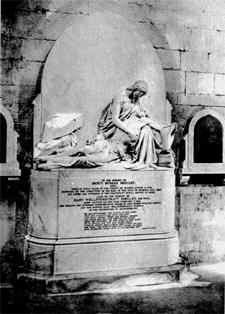 |


|
|
By John Lauritsen
"The biographer who must sift the evidence for the sexual proclivities of a historic personality faces a challenging task. The subjects themselves almost always took great precautions to destroy or have their heirs and executors destroy any 'incriminating' evidence. Then their biographers bent over backwards to shield them from accusations of homosexuality." (Johansson & Percy) I'll use the following definition: A man is gay if male love is an important part in his life -- with male love understood as comprising love, sex, and friendship. "Bisexuals" are included in the gay category. Intuitively one wants to claim Shelley as gay. In appearance he was good-looking, feminine, and youthful. (Even in the final year of his life, as he was approaching 30, he looked like a teenager.) He passionately expressed his love for other males, and they fell in love with him. He was fascinated with the idea of androgyny. And he discussed male love and homoeroticism in some of his writings. At the same time, there was undeniably a heterosexual component in Shelley's makeup. He had two wives and several children. The waters have been muddied here by a campaign of disinformation waged by Shelley's widow, Mary, and her daughter- in-law, Lady Jane Shelley -- a campaign described as "the fraudulent and mistaken efforts to turn the romantic, pagan Shelley, as Hogg, Peacock, and Trelawny knew him in the flesh, into a Victorian angel suitable for enshrinement among the gods of respectability and convention." (Smith)
She commissioned a life-sized statuary by Weekes, blatantly modeled on Italian Pietas, which depicts Shelley-as-Jesus expiring in the arms of Mary (thus fostering a double Mariolatry). It goes without saying that the fabricators of the Shelley legend did their best to eradicate every trace of homoeroticism in the poet's life. In 1925 Edward Carpenter broached Shelley's gayness. As the author of The Intermediate Sex and Intermediate Types among Primitive Folk, Carpenter was keenly interested in the elements of androgyny in Shelley's personal appearance, psychology and poetry, most notably in his poems, The Witch of Atlas (of which Mary disapproved) and "Epipsychidion". Carpenter observed that Shelley's relations with women were unhappy, transitory or "up in the air" -- whereas he "certainly attracted the devotion of his men friends ... and was capable of warm and faithful attachment to them." Carpenter makes a crucial point: "Since the whole weight of herd-suggestion actively fosters and encourages the expression of all feelings of love towards the opposite sex and actively represses any patently homosexual expression, one clear indication of the latter is worth more as evidence than a dozen conventional signs of the former." (Carpenter)
But despite its excellence, the translation was suppressed and bowdlerized for well over a century. The established moral order of the 19th century could not countenance male love, which lies at the heart of the dialogue. Shelley began translating The Banquetduring the summer of 1818, when he was 26 years old. Working as though possessed by a Platonic Daemon, he finished the translation in ten days. Shelley then wrote an introductory essay, with the dubious intention of helping his wife understand "the manners and feelings of the Athenians" (and also, presumably, his own). This essay, A Discourse on the Manners of the Antient Greeks Relative to the Subject of Love, is only the second in English (after an unpublished 1785 essay by Jeremy Bentham) to address male-to-male sexuality. (Crompton 1985) Unfortunately, it is flawed on several counts. An over-wrought feminism leads Shelley to maintain that women in Ancient Greece were so degraded that the males had to turn to each other for amatory satisfaction. And he almost hysterically denies that the Greeks could have engaged in acts that were "disgusting" or associated with "pain and horror" (probably references to anal intercourse). At any rate, Shelley had no serious thought of publishing either translation or essay, though he showed them to his friends. We should remember that even into the fourth decade of the 19th century, males in England, including adolescent boys, were hanged for having sex with each other. The death penalty for "buggery" remained in effect until 1861 in England, and until 1887 in Scotland. In July 1822, just short of his 30th birthday, Shelley was drowned in a boating accident. Eighteen years later his widow Mary, aided by Leigh Hunt, published the translation, but in a highly bowdlerized form: they changed "love" to "friendship", "his beloved" to "the other", "men" to "human beings", and so on; they lopped off offending passages and entire episodes. This travesty was the version the world knew until 1931, when translation and essay were finally published in their entirety -- in a private edition of only 100 copies. (Ingpen) Since later biographers have been misled by the pious- Shelley myth-makers, we must turn to Shelley's own writings and those of his friends, where there are abundant indications of male love. The most exciting account, and a precious document of the English Romantic Movement, is by Edward John Trelawny, his Recollections of Shelley and Byron. An ex-buccaneer--tall,dark, and handsome--Trelawny was the same age as Shelley, 29, when they met. Though he only knew Shelley for the last half year of his life, Trelawny fell immediately in love, a love which lasted for the rest of his life. His description of their first meeting is unforgettable: "Swiftly gliding in, blushing like a girl, a tall thin stripling held out both his hands; and although I could hardly believe as I looked at his flushed, feminine, and artless face that it could be the Poet, I returned his warm pressure." (Trelawny 1858) Trelawny's bravado enables him to get away with outrageous or indiscreet statements. For example, he gives a long and loving description of Shelley's appearance and body, and casually remarks that he often saw Shelley "in a state of nudity".
"A clergyman wrote in the visitors' book at the Mer de Glace, Chamouni, something to the following effect: 'No one can view this sublime scene, and deny the existence of God.' Under which Shelley, using a Greek phrase, wrote, 'P.B. Shelley, Atheist,' thereby proclaiming his opinion to all the world. And he never regretted having done this." When Trelawny finally died, at the age of 88, his ashes were buried next to Shelley's in the Protestant Cemetery in Rome, in a grave he had reserved almost 60 years earlier. His letters were burned. Shelley's dearest friend in life was Thomas Jefferson Hogg, who was expelled from Oxford with him, when they were both 18, over a pamphlet Shelley had published, "The Necessity of Atheism". They then lived together until they were separated by their families. Shelley's letters to Hogg contain such phrases as "brother of my soul", "he whom I love" and "my bosom friend". (Hogg) According to Trelawny, Thomas Jefferson Hogg's love for Shelley was "the one bit of romance in his life". (Smith) Hogg's reminiscences of Shelley, written 36 years after his death, are a loving tribute, and include numerous hints as to male love. For example, a dandified French duke remarks to Hogg that Shelley's cough should be treated with "Eau de Luce ... frequently rubbed on his chest by a soft, warm hand." When Hogg innocently asks where Shelley will find the soft, warm hand, the duke replies, "Oh! with his truly charming physiognomy, he will very easily find that!" (Hogg) Hogg includes Shelley's Essay on Friendship, which describes his love for another schoolboy. Dedicated to Hogg, "that my friendship will no longer be an enigma to my friend", it was written in the last year of his life. At the end of his biography, Hogg reaches the point where Shelley has met Mary Wollenstonecraft Godwin, the woman who, through threats of suicide and blandishments of Free Love, would steal him away from his pregnant wife and child. Hogg poses the question, "Did he love her [Mary]?", and then poses it again, "Did he love her?" Hogg has led the reader to expect that the question will be answered, but instead he tells two stories -- of teen-aged boys who loved and were loved by Shelley. The first boy, a young officer in a marching regiment, was 16 and Shelley was 22 when they met. The second was a close friend of Shelley, and later Hogg, from the time he left the Navy at the age of 15. Thus the book ends. This would seem to be Hogg's way of saying, slyly and indirectly, that Shelley did not ever love Mary, because his true love interests were young men. Thomas Love Peacock, in his Memoirs of Percy Bysshe Shelley, explains why he has previously refused to write about Shelley's life: "If there be in the life of the subject of the biographer any event which he himself would willingly have blotted from the tablet of his own memory ... if such an event be the cardinal point of a life ... then, as there is no moral compulsion to speak of the matter at all, it is better to let the whole story slumber in silence." (Peacock) Shelley's sexual attraction to other males may well be what Peacock had in mind.
For six years Shelley was a close friend of his fellow Romantic Poet, Byron, who was boldly gay for the time. (Crompton) Byron described Shelley as "the most gentle, the most admirable and least worldly-minded person I ever met." (Smith) Byron's memoirs were burned after his death. The first Shelley biography was by his cousin, Thomas Medwin, who had known him from childhood. In a letter of 1820, Shelley urges Medwin to join him in Italy, "the Paradise of exiles, the retreat of Pariahs", which Medwin did. In his biography, Medwin includes two Shelley descriptions of homoerotic sculptures in the Uffizi gallery, commenting wryly that Mary Shelley had "omitted" them from her edition of Shelley's prose works. Medwin decisively refutes the rumor that Shelley was having an affair with Jane Williams. Although Shelley was fond of Jane, it was her common-law husband, Edward Ellerker Williams, whom he loved, and with whom he died, along with the "smart sailor lad" Charles Viviani, aged 18. According to Medwin, Shelley intended his Epitaph for Two Friends for himself and Williams. There are several variants, of which Medwin gives the following: They were two friends, whose life was undivided. So let them mingle. Sweetly they had glided Under the grave. Let not their dust be parted, For their two hearts in life were single-hearted. To sum up: One cannot say with certainty that Shelley ever had sex with another male, or with whom. But then, with the destruction of diary pages, the burning of letters and memoirs, and the massive fabrication of respectability, this might be expected. My personal guess is that he did have gay sex, and with a number of different partners. After all, Shelley did espouse Free Love, and he was not at all shy about taking his clothes off. At minimum I maintain, and with conviction, that male love was at the center of Shelley's life, and that therefore he was gay. References Edward Carpenter, The Psychology of the Poet Shelley, 1925. Louis Crompton, Byron and Greek Love: Homophobia in 19th Century England, 1985. Wayne R. Dynes (editor), Encyclopedia of Homosexuality, 1990. Noel I. Garde, From Jonathan to Gide: The Homosexual in History, 1964. Thomas Jefferson Hogg, The Life of Percy Bysshe Shelley, 1858. Warren Johansson and William A. Percy, Outing: Shattering the Conspiracy of Silence, 1994. H.J. Massingham, The Friend of Shelley: A Memoir of Edward John Trelawny, 1930. Thomas Medwin, The Life of Percy Bysshe Shelley, 1847; New, expanded edition edited by H. Buxton Forman, 1913. Thomas Love Peacock, Memoirs of Percy Bysshe Shelley, 1858-1862. Walter Sidney Scott (editor), The Athenians: Being Correspondence Between Thomas Jefferson Hogg and his Friends Thomas Love Peacock, Leigh Hunt, Percy Bysshe Shelley and Others, 1943 Robert Metcalf Smith, The Shelley Legend, 1945. Edward John Trelawny, Recollections of Shelley and Byron, 1858. -- Records of Shelley, Byron, and the Author, 1878. Percy Bysshe Shelley's translation of The Banquet (or Symposium) can be ordered directly for $8.00 postpaid* Pagan Press P.O. Box 1902 Provincetown, Massachusetts 02657-0245 Telephone: (508) 487-8369 E-mail: john_lauritsen@post.harvard.edu *For overseas airmail add $3. Check must be in U.S. dollars, drawn on a U.S. bank. |

© 1997-2002 BEI
 Percy Bysshe Shelley, as drawn by his lover, Edward Ellerker Williams
Percy Bysshe Shelley, as drawn by his lover, Edward Ellerker Williams I have just published one of Shelley's greatest, though
least known, compositions: his translation of Plato's great
Dialogue on Love, The Banquet (or Symposium). This translation is
not only the best in English, it is a masterpiece in its own
right.
I have just published one of Shelley's greatest, though
least known, compositions: his translation of Plato's great
Dialogue on Love, The Banquet (or Symposium). This translation is
not only the best in English, it is a masterpiece in its own
right.
 E.J. Trelawny in old age:
E.J. Trelawny in old age: